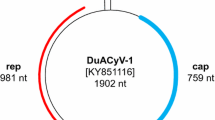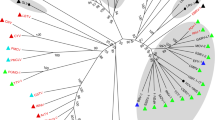Abstract
Three cycloviruses (genus Cyclovirus, family Circoviridae) were recovered from a dragonfly (Odonata: Anisoptera) captured in Fuzhou, China. The three cycloviruses, named dragonfly associated cyclovirus 9, 10 and 11 (DfCyV-9, -10, -11), respectively, show 56.1-79.6% genome-wide identity to known cycloviruses and 61.6-65.1% among themselves. Thus, according to the current species demarcation criteria, they represent three novel cycloviruses. Notably, DfCyV-10 has a predicted replication-associated protein (Rep) that is most similar to that of bat associated cyclovirus 2 (BatACyV-2), a cyclovirus discovered in China, with 79.4% amino acid sequence identity, but a putative capsid protein (Cp) most similar to that of BatACyV-10, a cyclovirus discovered in Brazil, with 71.7% amino acid sequence identity. These data are useful for understanding the diversity and evolution of cycloviruses, especially those found in insects.


Similar content being viewed by others
References
Allan GM, Ellis JA (2000) Porcine circoviruses: a review. J Vet Diag Invest 12:3–14
Biagini P, Bendinelli M, Hino S, Kakkola L, Mankertz A, Niel C, Okamoto H, Raidal S, Teo CG, Todd D (2012) Family Circoviridae. In: King AMQ, Lindberg AM, Pallansch MA, Palmenberg AC, Simmonds P (eds) Virus taxonomy: classification and nomenclature of viruses: ninth report of the International Committee on Taxonomy of Viruses. Academic Press, London, pp 343–349
Dayaram A, Potter KA, Moline AB, Rosenstein DD, Marinov M, Thomas JE, Breitbart M, Rosario K, Argüello-Astorga GR, Varsani A (2013) High global diversity of cycloviruses amongst dragonflies. J Gen Virol 94:1827–1840
Delwart E, Li L (2012) Rapidly expanding genetic diversity and host range of the Circoviridae viral family and other Rep encoding small circular ssDNA genomes. Virus Res 164:114–121
Edgar RC (2004) MUSCLE: multiple sequence alignment with high accuracy and high throughput. Nucl Acids Res 32:1792–1797
Ge X, Li J, Peng C, Wu L, Yang X, Wu Y, Zhang Y, Shi Z (2011) Genetic diversity of novel circular ssDNA viruses in bats in China. J Gen Virol 92:2646–2653
Kalyaanamoorthy S, Minh BQ, Wong TKF, von Haeseler A, Jermiin LS (2017) ModelFinder: fast model selection for accurate phylogenetic estimates. Nat Methods 14:587
Li L, Kapoor A, Slikas B, Bamidele OS, Wang C, Shaukat S, Masroor MA, Wilson ML, Ndjango J-BN, Peeters M (2010) Multiple diverse circoviruses infect farm animals and are commonly found in human and chimpanzee feces. J Virol 84:1674–1682
Male MF, Kraberger S, Stainton D, Kami V, Varsani A (2016) Cycloviruses, gemycircularviruses and other novel replication-associated protein encoding circular viruses in Pacific flying fox (Pteropus tonganus) faeces. Infec Gen Evo 39:279–292
Muhire BM, Varsani A, Martin DP (2014) SDT: a virus classification tool based on pairwise sequence alignment and identity calculation. PloS One 9:e108277
Nguyen L-T, Schmidt HA, von Haeseler A, Minh BQ (2014) IQ-TREE: a fast and effective stochastic algorithm for estimating maximum-likelihood phylogenies. Mol Biol Evo 32:268–274
Padilla-Rodriguez M, Rosario K, Breitbart M (2013) Novel cyclovirus discovered in the Florida woods cockroach Eurycotis floridana (Walker). Arch Virol 158:1389–1392
Phan TG, Luchsinger V, Avendano LF, Deng X, Delwart E (2014) Cyclovirus in nasopharyngeal aspirates of Chilean children with respiratory infections. J Gen Virol 95:922–927
Rosario K, Marinov M, Stainton D, Kraberger S, Wiltshire EJ, Collings DA, Walters M, Martin DP, Breitbart M, Varsani A (2011) Dragonfly cyclovirus, a novel single-stranded DNA virus discovered in dragonflies (Odonata: Anisoptera). J Gen Virol 92:1302–1308
Rosario K, Dayaram A, Marinov M, Ware J, Kraberger S, Stainton D, Breitbart M, Varsani A (2012) Diverse circular ssDNA viruses discovered in dragonflies (Odonata: Epiprocta). J Gen Virol 93:2668–2681
Rosario K, Breitbart M, Harrach B, Segalés J, Delwart E, Biagini P, Varsani A (2017) Revisiting the taxonomy of the family Circoviridae: establishment of the genus Cyclovirus and removal of the genus Gyrovirus. Arch Virol 162:1447–1463
Smits SL, Zijlstra E, van Hellemond JJ, Schapendonk CME, Bodewes R, Schürch AC, Haagmans BL, Osterhaus ADME (2013) Novel cyclovirus in human cerebrospinal fluid, Malawi, 2010–2011. Emer Infect Dis 19:1511–1513
Tan LV, van Doorn HR, Nghia HD, Chau TT, Tu LTP, de Vries M, Canuti M, Deijs M, Jebbink MF, Baker S, Bryant JE, Tham NT, BKrong NTTC, Boni MF, Loi TQ, Phuong LT, Verhoeven JT, Crusat M, Jeeninga RE, Schultsz C, Chau NV, Hien TT, van der Hoek L, Farrar J, de Jong MD (2013) Identification of a new cyclovirus in cerebrospinal fluid of patients with acute central nervous system infections. MBio 4:e00213–e00231
Todd D (2000) Circoviruses: immunosuppressive threats to avian species: a review. Avian Pathol 29:373–394
Wu Z, Yang L, Ren X, He G, Zhang J, Yang J, Qian Z, Dong J, Sun L, Zhu Y (2016) Deciphering the bat virome catalog to better understand the ecological diversity of bat viruses and the bat origin of emerging infectious diseases. ISME J 10:609–620
Acknowledgments
This work was supported by a fund from the State Tobacco Monopoly Administration (110201601024(LS-04)) and an FAFU fund for excellent young scholars (xjq201622). We are grateful to Dr. Fangluan Gao at the College of Plant Protection, Fujian Agriculture and Forestry University, for his help in constructing the phylogenetic tree.
Author information
Authors and Affiliations
Corresponding authors
Ethics declarations
Conflict of interest
The author declares no competing interests.
Ethical approval
All applicable international, national, and/or institutional guidelines for the care and use of animals were followed. This article does not contain any studies with human participants performed by any of the authors.
Additional information
Handling Editor: T. K. Frey.
Electronic supplementary material
Below is the link to the electronic supplementary material.
705_2018_3876_MOESM1_ESM.png
Supplementary Fig. 1 Pairwise comparisons among dragonfly associated cyclovirus 9, 10 and 11 (DfCyV-9, -10, and -11) and members of the genus Cyclovirus, including identity values based on the replication-associated (Rep) (A) and capsid (Cp) (B) protein coding sequences
Rights and permissions
About this article
Cite this article
Islam, S.U., Lin, W., Wu, R. et al. Complete genome sequences of three novel cycloviruses identified in a dragonfly (Odonata: Anisoptera) from China. Arch Virol 163, 2569–2573 (2018). https://doi.org/10.1007/s00705-018-3876-9
Received:
Accepted:
Published:
Issue Date:
DOI: https://doi.org/10.1007/s00705-018-3876-9




